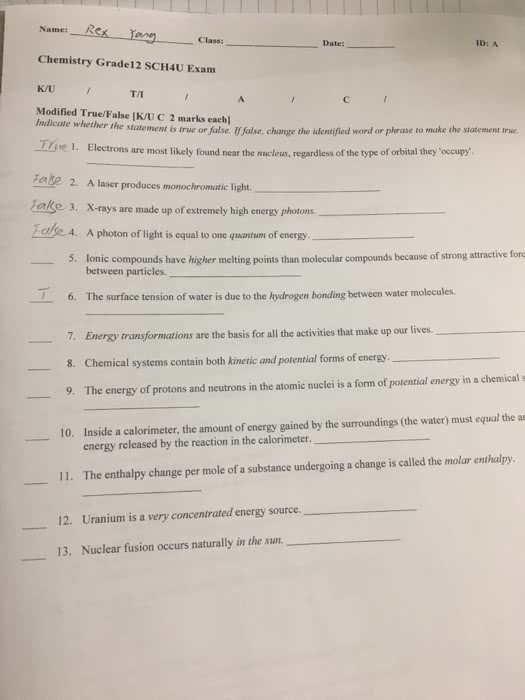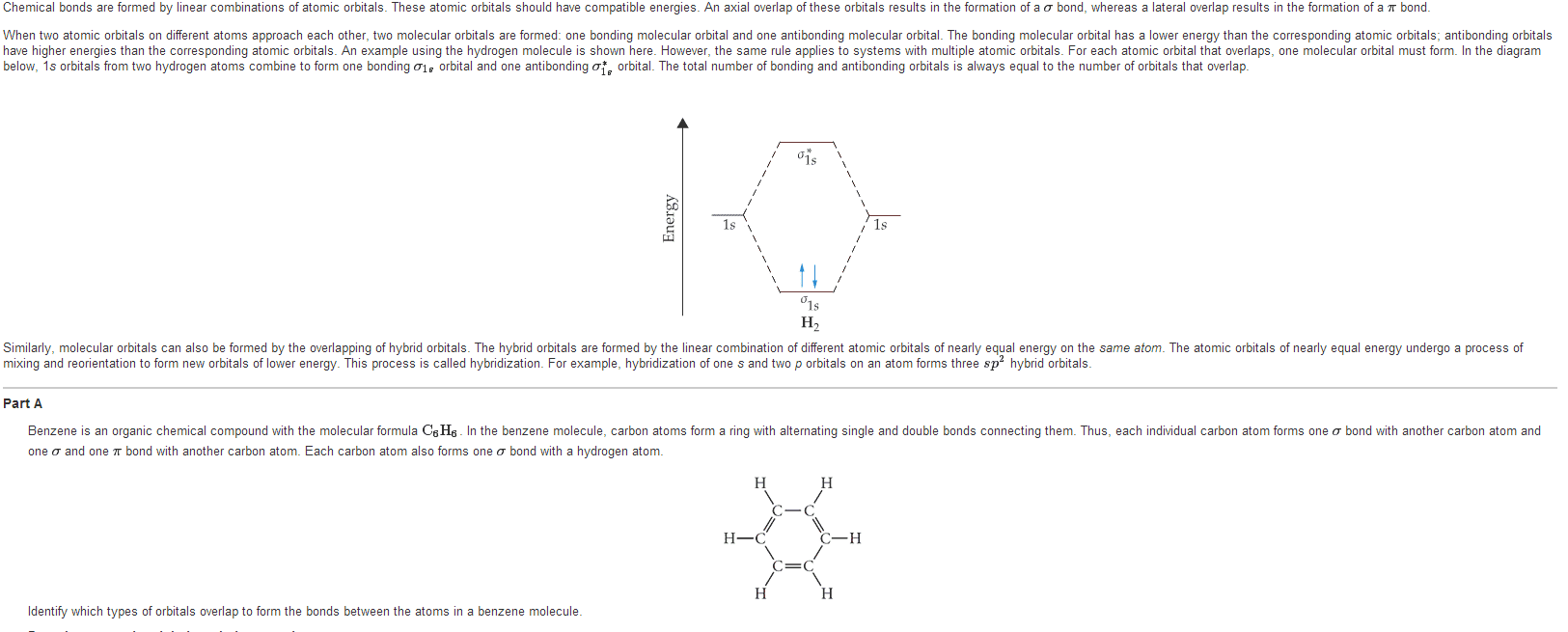These are 10 fairly straight foward mutiple choice questions. Toget full Points you NEED to provide a breiefscentence on why you chose each answer. Many of the questions haveimage Links provided.
1. Image-https://secure.surveymonkey.com/_resources/15782/40125782/d67f4c3b-457d-4537-b1d9-471bf9a7064b.jpg
The diagram (Figure 1) above shows the reaction between hydrogenand iodine.
The reaction between hydrogen (H2) and iodine (I2) to form hydrogeniodide (HI) (______________).
Which answer best completes the sentence?
The diagram (Figure 1) above shows the reaction between hydrogenand iodine. The reaction between hydrogen (H2) and iodine (I2) toform hydrogen iodide (HI) (______________). Which answer bestcompletes the sentence?
A. absorbs heat energy
B. releases heat energy
C. absorbs and releases equal amounts of heat energy
D. does not involve heat energy
2.Which of the following statements describes correctly what hashappened, in terms of energy, in the chemical reaction of sodiumwith chlorine to form sodium chloride?
Which of the following statements describes correctly what hashappened, in terms of energy, in the chemical reaction of sodiumwith chlorine to form sodium chloride?
A. The total output of energy is less than the total input ofenergy.
B. The total output of energy is greater than the total input ofenergy.
C. The total output of energy is the same as the total input ofenergy.
3. Image-https://secure.surveymonkey.com/_resources/15782/40125782/0e48e39f-2d59-4a2c-836f-3dcce462a043.jpg
(See Figure 2) What type of energy does each energy levelrepresent?
(See Figure 2) What type of energy does each energy levelrepresent?
A. Heat energy
B. Bond energy
C. Potential energy
D. Chemical energy
4. When the light generated by heated sodium chloride crystals in aflame is passed through a prism, a screen behind the prism showsyellow lines. Why does this phenomenon happen?
When the light generated by heated sodium chloride crystals in aflame is passed through a prism, a screen behind the prism showsyellow lines. Why does this phenomenon happen?
A. Because the flame used to heat the sodium chloride crystal has ayellow color.
B. Because electrons in sodium atoms give off a specific amount ofenergy.
C. Because sodium atoms react with chlorine atoms in the flame andreleases a certain amount of energy.
D. Because the prism absorbs other color lights and only transmitsyellow light.
5. Image-https://secure.surveymonkey.com/_resources/15782/40125782/230a15db-89c7-4f06-a9dd-35bdf4257910.jpg
Which of the above processes is spontaneous? (see Figure 3)
A. 1
B. 2
C. 3
D. 1 and 2
E. 2 and 3
F. 1 and 3
6. An excited electron gives off radiation as it moves back to alower energy level. Which of the following best describes theamount of energy of the radiation?
An excited electron gives off radiation as it moves back to a lowerenergy level. Which of the following best describes the amount ofenergy of the radiation?
A. The amount of energy of the radiation is arbitrary due to energyloss during the process
B. The amount of energy of the radiation is equal to the amount offinal energy plus the amount of initial energy of the electron
C. The amount of energy of the radiation is equal to the amount ofinitial energy minus the amount of final energy of the electron
7. Object 1 and Object 2 are both made up of the same type ofmolecules and the same number of molecules. Object 1 has morethermal energy than Object 2. Do the molecules of Object 1 havemore, less, or the same amount of kinetic energy as compared to themolecules of Object 2?
Object 1 and Object 2 are both made up of the same type ofmolecules and the same number of molecules. Object 1 has morethermal energy than Object 2. Do the molecules of Object 1 havemore, less, or the same amount of kinetic energy as compared to themolecules of Object 2? A. The molecules of Object 1 have morekinetic energy than the molecules of Object 2.
B. The molecules of Object 1 have less kinetic energy than themolecules of Object 2.
C. The molecules of Object 1 have the same amount of kinetic energyas the molecules of Object 2.
8. Image-https://secure.surveymonkey.com/_resources/15782/40125782/7750ebe4-1ce6-4a00-a068-918b06401621.jpg
(See Figure 4) Which of the following best explains the energychange of the gas particles in the cylinder as the gas is heated bya Bunsen burner? (Note: Assume that the gas is an ideal gas)
(See Figure 4) Which of the following best explains the energychange of the gas particles in the cylinder as the gas is heated bya Bunsen burner? (Note: Assume that the gas is an ideal gas)
A. The gas particles have more potential energy than before.
B. The gas particles have less potential energy than before.
C. The gas particles have same mechanical energy as before.
D. The gas particles have same kinetic energy as before.
E. The gas particles have more kinetic energy than before.
9. Image-https://secure.surveymonkey.com/_resources/15782/40125782/6b2874be-1d7c-479d-bc39-170af9bd7e59.jpg
(See Figure 5) After forming hydrogen iodide (HI), the entropy ofthe system is
(See Figure 5) After forming hydrogen iodide (HI), the entropy ofthe system is
A. same
B. increased
C. decreased
10. image-https://secure.surveymonkey.com/_resources/15782/40125782/d3e6981a-a4aa-46bb-85b0-f5fc8e505441.jpg
The picture above illustrates a closed system including a vesselcontaining a gas. As the temperature of the system increases, thegas lifts the piston along with the weight on top of it. If thesystem absorbed heat energy and lifted the piston, how has theinternal energy of the system changed? (Assume that the gas is anideal gas)
The picture above illustrates a closed system including a vesselcontaining a gas. As the temperature of the system increases, thegas lifts the piston along with the weight on top of it. If thesystem absorbed heat energy and lifted the piston, how has theinternal energy of the system changed? (Assume that the gas is anideal gas)
A. The change in internal energy is equal to the amount of heatenergy supplied to the system
B. The change in internal energy is equal to the amount ofincreasing potential energy of the piston
C. The change in internal energy is equal to the amount of heatenergy supplied to the system minus the amount of work done by thesystem
D. The change in internal energy is equal to the amount of workdone by the system on the surroundings
E. The change in internal energy is zero.
Chemistry



